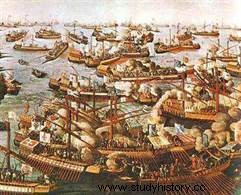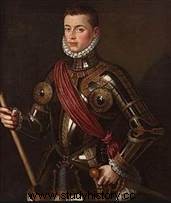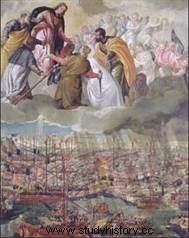 The Battle of Lepanto is a naval battle that took place on October 7, 1571, in the Gulf of Lepanto (Gulf of Corinth) between the Ottoman fleet of Ali Pasha and a Christian coalition comprising Spain, Malta, Venice, Genoa and the Papal States. Placed under the command of Don Juan of Austria , the Christian fleet won a resounding victory, sinking about fifty Turkish galleys, capturing more than 100 others and freeing 15,000 captive Christians. This battle was the first major success of the Christians against the Ottoman Empire and as such was psychologically decisive. It had little practical consequence, however, as the Turks retained supremacy on land, allowing them to quickly rebuild their fleet.
The Battle of Lepanto is a naval battle that took place on October 7, 1571, in the Gulf of Lepanto (Gulf of Corinth) between the Ottoman fleet of Ali Pasha and a Christian coalition comprising Spain, Malta, Venice, Genoa and the Papal States. Placed under the command of Don Juan of Austria , the Christian fleet won a resounding victory, sinking about fifty Turkish galleys, capturing more than 100 others and freeing 15,000 captive Christians. This battle was the first major success of the Christians against the Ottoman Empire and as such was psychologically decisive. It had little practical consequence, however, as the Turks retained supremacy on land, allowing them to quickly rebuild their fleet.
The Battle of Lepanto, an “ideological” confrontation
So, and more than for the Habsburgs , the Battle of Lepanto is for Venice the opportunity to find a second wind, while the country is losing momentum, and has been experiencing more and more and for several decades the effects of a crisis that is both commercial and economic. The battle is also considered a real religious crusade, led by the Christian Holy League against the Ottoman Turks, who are Muslims. Veronese magnificently underlined this religious inclination of the battles in his "Battle of Lepanto », painted in 1572 and exhibited at the Accademia in Venice.
Anyway, this naval battle is a major event:first of all because it is one of the most important of its kind in history in general, in particular by its painful toll and its scope, but also because it represents in a way a "confrontation ideological” very interesting in the context of the study of international relations in the sixteenth century.
 Indeed, throughout the sixteenth century, southern Europe, or rather the Mediterranean world, found itself literally fractured between the two great monotheistic religions of the time:Christianity, represented by the Holy League , and Islam, in the presence of the Ottoman Turks s. The Holy League, for its part, was a diplomatic alliance, which was created on May 25, 1571 by the Serenissima Republic of Venice , the Habsburg States of Spain, Naples and Sicily, the Republic of Genoa , the Hospitallers , the Duchy of Savoy, the Knights of Malta, the Papal States , as well as various Italian states. These States then undertook to provide nearly two hundred galleys on the 1
st
April each year; half the cost was to be borne by Spain, a third by Venice, and a sixth by the papacy. Command of the fleet was given to Don Juan of Austria , brother of Philip II King of Spain and illegitimate son of Charles V.
Indeed, throughout the sixteenth century, southern Europe, or rather the Mediterranean world, found itself literally fractured between the two great monotheistic religions of the time:Christianity, represented by the Holy League , and Islam, in the presence of the Ottoman Turks s. The Holy League, for its part, was a diplomatic alliance, which was created on May 25, 1571 by the Serenissima Republic of Venice , the Habsburg States of Spain, Naples and Sicily, the Republic of Genoa , the Hospitallers , the Duchy of Savoy, the Knights of Malta, the Papal States , as well as various Italian states. These States then undertook to provide nearly two hundred galleys on the 1
st
April each year; half the cost was to be borne by Spain, a third by Venice, and a sixth by the papacy. Command of the fleet was given to Don Juan of Austria , brother of Philip II King of Spain and illegitimate son of Charles V.
Faced with this Holy Alliance was therefore the Ottoman Empire, which, since the beginning of the 16th century, had been trying to seize control of the Mediterranean. Like the Viking raids of the 9th century, the Ottomans also made rapid incursions on the Spanish and Italian coasts, taking care to plunder the territories they crossed. When in 1570, the Ottomans seized Cyprus at the expense of Venice, notably by massacring nearly twenty thousand inhabitants of Nicosia, one more step was taken towards war. The Holy League was therefore formed, on the initiative of Pope Pius V, who appealed to the ideal of the medieval crusade . Christian states – Catholic ones, above all! - organize and unite against the Ottoman Turks. The conflict therefore seems inevitable, as the tension is great in the Mediterranean.
One of the most important naval battles in history
Despite everything, the Spaniards continue to doubt the imminence of the confrontation. On October 6, 1571, the Fleet of the Holy League presents itself in front of the Curzolari Islands, a tiny archipelago between Kefalonia and the mouth of the Gulf of Lepanto; two hundred and eight galleys are present:one hundred and six Venetian, ninety Spanish and Genoese, twelve pontifical. There are also galleasses, provided by Venice, and between twenty and thirty sailing ships. In total, the Holy League had almost two thousand pieces of artillery and eighty thousand men.
 Anchored in the harbor of Lepanto, the Turkish fleet is composed of two hundred and seventy galleys and seventy various buildings, implementing ninety thousand men for seven hundred and fifty pieces of artillery. The Ottoman warships were discovered at the tip of Malcanton at dawn on October 7, 1571. Don Juan of Austria stopped his galley, the Royal of Spain , and gives the signal for the deployment of his fleet, ten miles from the enemy forces. The Turks are stamping their feet with impatience:having received information – which turned out to be inaccurate – they then estimate the fleet of the Holy League at one hundred and seventy ships! Ali Pasha, the Ottoman commander, gives the order to deploy his fleet.
Anchored in the harbor of Lepanto, the Turkish fleet is composed of two hundred and seventy galleys and seventy various buildings, implementing ninety thousand men for seven hundred and fifty pieces of artillery. The Ottoman warships were discovered at the tip of Malcanton at dawn on October 7, 1571. Don Juan of Austria stopped his galley, the Royal of Spain , and gives the signal for the deployment of his fleet, ten miles from the enemy forces. The Turks are stamping their feet with impatience:having received information – which turned out to be inaccurate – they then estimate the fleet of the Holy League at one hundred and seventy ships! Ali Pasha, the Ottoman commander, gives the order to deploy his fleet.
The Spanish infantry then set off to board the Turkish galleys, literally locked in the Gulf of Lepanto. The ship of Ali Pasha was invaded by the men of the galley of Don Juan of Austria:the Turkish admiral was beheaded. According to legend, his head was placed at the end of the mast of the main Spanish ship… The Christian slaves themselves, held back by the Ottomans, took advantage of the rout of their jailers to break their chains and attack them with makeshift weapons.
The victory of Lepanto:a heavy toll and an immense impact
The Battle of Lepanto is rightly considered the greatest and most bloodthirsty in all of history. Alvise Zorzi, specialist in Venetian history and civilization, speaks in his History of Venice of a “horrible spectacle of the sea covered in blood, corpses, broken oars, masts. ". In reality, the Ottoman rout was total:the League captured one hundred and seventeen galleys, sent sixty-two to the bottom, seized thirteen galleys and nearly four hundred pieces of artillery. Three thousand five hundred Turkish galley slaves were captured, and the Ottomans lost twenty to thirty thousand men, without counting all those who were massacred by the Greeks in the coastal villages. In addition, fifteen thousand Christian slaves were freed.
On the side of the Sainte-Ligue, there are twenty thousand wounded and seven thousand five hundred dead. The Venetians paid the heaviest price , with four thousand seven hundred losses, which reinforces the legend elevating them to true heroes of the battle of Lepanto.
 Since the Battle of Actium in 31 BC. AD ., the Mediterranean had never known such a naval confrontation. From then on, Spanish hegemony over the Mediterranean was confirmed, and even increased. Psychologically, the victory had a considerable impact in Europe, and in particular in Venice:more than a military victory, it was truly the triumph of Christianity against the Ottomans , Muslims.
Since the Battle of Actium in 31 BC. AD ., the Mediterranean had never known such a naval confrontation. From then on, Spanish hegemony over the Mediterranean was confirmed, and even increased. Psychologically, the victory had a considerable impact in Europe, and in particular in Venice:more than a military victory, it was truly the triumph of Christianity against the Ottomans , Muslims.
Furthermore, the Battle of Lepanto truly marks the end of Ottoman expansionism in the Mediterranean, to the benefit of Spain. But the stakes, after 1571, are already elsewhere, on the side of America, where the Spaniards must face the famous revolt of Tupac Amaru in Peru. Andrew Wheatcroft, in his book Infidels:A History of the Conflict between Christendom and Islam , speaks in particular of the existence, through the outcome of the conflict, of a certain "European consciousness".
Be that as it may, more than a strategic victory – and in particular a commercial and economic one –, the battle of Lepanto exposed the triumph of Christianity over Islam, of the " Venetian martyrs over the Ottomans. Added to the military and naval triumph is an ideological dimension undeniable, even capital.
In the imagination of many Venetians, even today, Lepanto represents a real pride, a moment of glory e that many like to recall, the Venetian fighters having been hailed for their bravery. The Museo Correr in Venice, located in Saint Mark's Square, and directly facing the majestic eponymous basilica, still exhibits four gigantic and splendid canvases testifying to the bitterness of these fights, while taking great care to praise the Serenissima and its centuries-old openness to the sea.
Bibliography
- The Battle of Lepanto (1571) by Henri Pigaillem. Economica, 2003.
- The Battle of the Three Empires:Lepanto, 1571, by Alessandro Barbero. Fields History, 2014.
